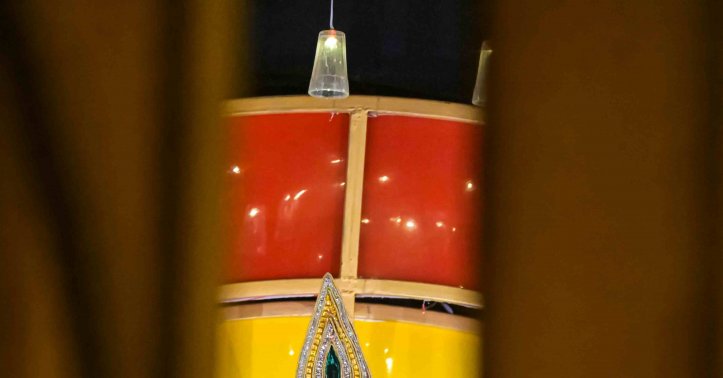
Navamsha and Navaratri
This is a fascinating and profound connection in Vedic (Hindu) tradition. The link between Navamsa in astrology and Navaratri is deep, resting on the shared root concept of "nine" (Nava) and the archetype of the Divine Feminine.
Let's break it down.
1. Navamsa (Navamsha) in Astrology: The Divisional Chart of Dharma
Meaning: "Navamsa" literally means "the ninth division." It is one of the most important divisional charts (Varga charts) in Vedic astrology.
What it is:
It is created by dividing each of the 30 degrees of a zodiac sign into 9 equal parts. So, 30° x 9 = 270 parts per sign. Across 12 signs, this creates a harmonic chart of 12 x 9 = 108 Navamsas. (Note the sacred number 108).
Each Navamsa division is 3 degrees and 20 minutes long.
Every sign is ruled by a specific sequence of planets in the Navamsa chart.
Purpose and Significance:
The Spouse and Marriage: It is most famously known as the chart that reveals details about one's life partner, the nature of marriage, and the quality of partnerships.
The Fruit of Action (Dharma): More profoundly, the Navamsa is considered the D-9 chart, representing the 9th house of the birth chart. The 9th house is the house of Dharma (life's purpose), fortune, and higher learning. Therefore, the Navamsa shows the fruit of your Dharma—the results of your past actions and the true unfolding of your life's purpose.
Strength of Planets: A planet placed in a particular Navamsa sign is said to be strengthened or weakened. A planet in its own Navamsa sign is considered very strong.
The Soul's True Path: Many astrologers consider the Navamsa chart to be as important as the birth chart (Lagna chart). If the birth chart shows the "potential," the Navamsa shows how that potential will actually manifest—it reveals the soul's true path and spiritual destiny.
In essence, the Navamsa is the hidden, finer blueprint of your destiny, particularly concerning relationships and spiritual fulfillment.
2. Navaratri: The Nine Nights of the Goddess
Meaning: "Navaratri" literally means "nine nights." It is one of the most significant Hindu festivals, celebrated twice a year (and in some traditions, four times).
What it is:
It is a nine-night and ten-day festival dedicated to the worship of the Divine Feminine in her various forms—primarily Goddess Durga, Lakshmi, and Saraswati.
The most widely celebrated Navaratris are:
Sharada Navaratri (Autumn): In the lunar month of Ashwin (Sept-Oct).
Chaitra Navaratri (Spring): In the lunar month of Chaitra (March-April).
Purpose and Significance:
The Triumph of Good over Evil: It commemorates the victory of Goddess Durga over the buffalo demon Mahishasura, symbolizing the victory of divine consciousness and good over negative tendencies and evil.
Spiritual Evolution: The nine nights represent a spiritual journey. Each day is dedicated to a different form (manifestation) of the Goddess, guiding the devotee through a process of inner purification and elevation.
Days 1-3: Goddess Durga - Destroying impurities, vices, and negative tendencies.
Days 4-6: Goddess Lakshmi - Invoking spiritual and material prosperity and harmony.
Days 7-9: Goddess Saraswati - Bestowing wisdom, knowledge, and enlightenment.
The Tenth Day: Vijayadashami - The "day of victory," marking the successful completion of the inner battle and the acquisition of blessings.
In essence, Navaratri is a period of intense spiritual practice to conquer the inner demon (our lower self) and realize our true, divine nature.
The Profound Connection: The "Nava" (Nine) and the Journey of the Soul
The connection is not a direct, technical one in astrology but a profound philosophical and symbolic parallel.
Feature Navamsa (Astrology) Navaratri (Festival)
Core Meaning The Ninth Division The Nine Nights
Central Theme Unfolding of Dharma & Partnerships Worship of the Divine Feminine
The "Journey" A journey through the 9 divisions of a sign to reveal the soul's deeper destiny and the nature of its unions. A journey through 9 nights of worship to purify the soul and unite it with the Divine.
Symbolism of 9 Represents the 9 planets (Navagraha) influencing our karma. The chart refines their expression. Represents the 9 forms of the Goddess (Nava-Durga) that guide our spiritual evolution.
The "Partner" The Navamsa chart explicitly reveals the life partner (spouse). The Divine Feminine (Shakti) is seen as the ultimate consort and energy of the Divine (Shiva). The seeker is the "jiva" (soul) seeking union with the "divine partner."
The "Fruit" Shows the fruit of your Dharma (past actions and purpose). The festival is performed to gain the fruit of spiritual practice (Moksha, blessings, victory).
Ultimate Goal To understand and align with one's true spiritual path and the karmic relationships that facilitate it. To destroy inner demons (like Mahishasura - Tamas/Rajas) and attain spiritual victory (Sattva/Self-Realization).
Synthesis: The Shared Allegory
Think of it this way:
Your Birth Chart (Lagna) is like the raw material of your life—your personality, circumstances, and inherent tendencies (your "Mahishasura").
The Navamsa is the detailed map of your Dharma, showing the path you must walk to fulfill your soul's purpose, including the key relationship (your "Divine Partner"/Spouse) who will aid you on that journey.
Navaratri is the prescribed spiritual process to walk that path. It is the active, devotional practice of invoking the Divine Feminine (the energies of the Navamsa) within to destroy your inner obstacles (shown by afflictions in the birth chart) and achieve the spiritual victory and union that the Navamsa promises.
This is a fascinating and profound connection in Vedic (Hindu) tradition. The link between Navamsa in astrology and Navaratri is deep, resting on the shared root concept of "nine" (Nava) and the archetype of the Divine Feminine.
Let's break it down.
1. Navamsa (Navamsha) in Astrology: The Divisional Chart of Dharma
Meaning: "Navamsa" literally means "the ninth division." It is one of the most important divisional charts (Varga charts) in Vedic astrology.
What it is:
It is created by dividing each of the 30 degrees of a zodiac sign into 9 equal parts. So, 30° x 9 = 270 parts per sign. Across 12 signs, this creates a harmonic chart of 12 x 9 = 108 Navamsas. (Note the sacred number 108).
Each Navamsa division is 3 degrees and 20 minutes long.
Every sign is ruled by a specific sequence of planets in the Navamsa chart.
Purpose and Significance:
The Spouse and Marriage: It is most famously known as the chart that reveals details about one's life partner, the nature of marriage, and the quality of partnerships.
The Fruit of Action (Dharma): More profoundly, the Navamsa is considered the D-9 chart, representing the 9th house of the birth chart. The 9th house is the house of Dharma (life's purpose), fortune, and higher learning. Therefore, the Navamsa shows the fruit of your Dharma—the results of your past actions and the true unfolding of your life's purpose.
Strength of Planets: A planet placed in a particular Navamsa sign is said to be strengthened or weakened. A planet in its own Navamsa sign is considered very strong.
The Soul's True Path: Many astrologers consider the Navamsa chart to be as important as the birth chart (Lagna chart). If the birth chart shows the "potential," the Navamsa shows how that potential will actually manifest—it reveals the soul's true path and spiritual destiny.
In essence, the Navamsa is the hidden, finer blueprint of your destiny, particularly concerning relationships and spiritual fulfillment.
2. Navaratri: The Nine Nights of the Goddess
Meaning: "Navaratri" literally means "nine nights." It is one of the most significant Hindu festivals, celebrated twice a year (and in some traditions, four times).
What it is:
It is a nine-night and ten-day festival dedicated to the worship of the Divine Feminine in her various forms—primarily Goddess Durga, Lakshmi, and Saraswati.
The most widely celebrated Navaratris are:
Sharada Navaratri (Autumn): In the lunar month of Ashwin (Sept-Oct).
Chaitra Navaratri (Spring): In the lunar month of Chaitra (March-April).
Purpose and Significance:
The Triumph of Good over Evil: It commemorates the victory of Goddess Durga over the buffalo demon Mahishasura, symbolizing the victory of divine consciousness and good over negative tendencies and evil.
Spiritual Evolution: The nine nights represent a spiritual journey. Each day is dedicated to a different form (manifestation) of the Goddess, guiding the devotee through a process of inner purification and elevation.
Days 1-3: Goddess Durga - Destroying impurities, vices, and negative tendencies.
Days 4-6: Goddess Lakshmi - Invoking spiritual and material prosperity and harmony.
Days 7-9: Goddess Saraswati - Bestowing wisdom, knowledge, and enlightenment.
The Tenth Day: Vijayadashami - The "day of victory," marking the successful completion of the inner battle and the acquisition of blessings.
In essence, Navaratri is a period of intense spiritual practice to conquer the inner demon (our lower self) and realize our true, divine nature.
The Profound Connection: The "Nava" (Nine) and the Journey of the Soul
The connection is not a direct, technical one in astrology but a profound philosophical and symbolic parallel.
Feature Navamsa (Astrology) Navaratri (Festival)
Core Meaning The Ninth Division The Nine Nights
Central Theme Unfolding of Dharma & Partnerships Worship of the Divine Feminine
The "Journey" A journey through the 9 divisions of a sign to reveal the soul's deeper destiny and the nature of its unions. A journey through 9 nights of worship to purify the soul and unite it with the Divine.
Symbolism of 9 Represents the 9 planets (Navagraha) influencing our karma. The chart refines their expression. Represents the 9 forms of the Goddess (Nava-Durga) that guide our spiritual evolution.
The "Partner" The Navamsa chart explicitly reveals the life partner (spouse). The Divine Feminine (Shakti) is seen as the ultimate consort and energy of the Divine (Shiva). The seeker is the "jiva" (soul) seeking union with the "divine partner."
The "Fruit" Shows the fruit of your Dharma (past actions and purpose). The festival is performed to gain the fruit of spiritual practice (Moksha, blessings, victory).
Ultimate Goal To understand and align with one's true spiritual path and the karmic relationships that facilitate it. To destroy inner demons (like Mahishasura - Tamas/Rajas) and attain spiritual victory (Sattva/Self-Realization).
Synthesis: The Shared Allegory
Think of it this way:
Your Birth Chart (Lagna) is like the raw material of your life—your personality, circumstances, and inherent tendencies (your "Mahishasura").
The Navamsa is the detailed map of your Dharma, showing the path you must walk to fulfill your soul's purpose, including the key relationship (your "Divine Partner"/Spouse) who will aid you on that journey.
Navaratri is the prescribed spiritual process to walk that path. It is the active, devotional practice of invoking the Divine Feminine (the energies of the Navamsa) within to destroy your inner obstacles (shown by afflictions in the birth chart) and achieve the spiritual victory and union that the Navamsa promises.
In conclusion: Both Navamsa and Navaratri use the power of "nine" to map a journey from the gross to the subtle, from potential to manifestation, and from individual consciousness to a divine union. The Navamsa is the astrological blueprint for your spiritual destiny and partnerships, while Navaratri is the religious and practical methodology to achieve it.
By Jamuna Rangachari








